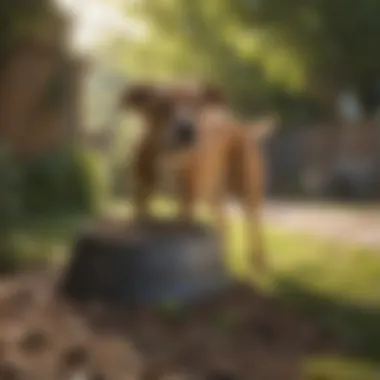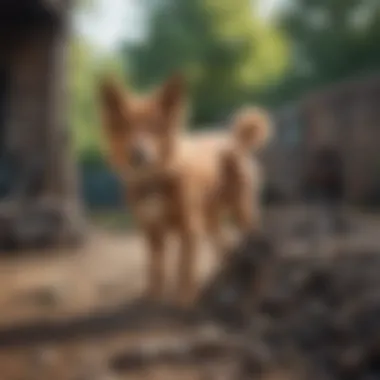Utilizing Lime for Effective Dog Waste Management


Intro
Managing dog waste is an essential aspect of responsible pet ownership. It involves not only the immediate clean-up after your dog but also the long-term impact on the environment. While many pet owners resort to traditional methods, lime offers a solution that requires exploration. This guide aims to provide a comprehensive understanding of how lime can be effectively used for managing dog waste, discussing its chemical properties, effectiveness, and any associated safety concerns.
Additionally, by examining the environmental impact and addressing misconceptions, this article encourages pet owners to use lime responsibly while highlighting various methods of waste management. With the right knowledge, pet owners can contribute to a cleaner and safer environment for their dogs and the community.
Pet Care and Grooming
While lime plays a significant role in waste management, it is also important for pet owners to practice regular care and grooming of their pets. This section covers various aspects of pet care that ensure the well-being of dogs and contribute to a cleaner space for waste management.
Importance of Regular Care
Regular care is vital for a dog's health and hygiene. Ensuring dogs are clean reduces the chance of odor and the spread of parasites. It is also key to maintaining a manageable area for waste disposal. A well-groomed dog will also exhibit fewer behaviors related to anxiety or discomfort.
Grooming Techniques by Pet Type
Different dog breeds have distinct grooming needs. Here are techniques based on pet type:
- Short-haired dogs: Use a rubber grooming glove or soft brush to manage shedding.
- Long-haired dogs: Regular brushing is essential to prevent matting and tangles.
- Active breeds: After outdoor play, wipe paws and check for debris or injuries.
Tools and Products Recommendations
Utilizing the right grooming tools can make a significant difference. Here are some recommended tools:
- Brushes: SleekEZ or Hertzko self-cleaning brush for various fur types.
- Shampoos: Earthbath or Burt’s Bees for natural and effective cleaning.
Seasonal Care Tips
Seasonal changes can affect grooming needs:
- Spring/Fall: Increased shedding necessitates more frequent grooming.
- Winter: Regular paw checking for ice build-up and salt irritation is important.
Health and Nutrition
A dog's health is closely linked to its nutrition. Understanding pet nutrition is essential for overall well-being and can affect waste management.
Understanding Pet Nutrition
The right diet is crucial. A balanced diet affects digestion and thus impacts the volume and consistency of waste. Consider consulting a vet for dietary options tailored to your dog's specific needs.
Common Health Issues by Species
Be aware of prevalent health issues that affect dogs:
- Obesity: Can lead to various health complications, including joint problems.
- Dental disease: Proper nutrition and dental care can prevent issues.
Preventive Care and Regular Check-Ups
Regular vet visits are crucial. Vaccinations, parasite control, and routine check-ups ensure a healthy dog. This minimizes the risk of waste-related health issues.
Food and Dietary Advice
Feeding high-quality food can make a significant difference. Ingredients should be clear, with a focus on protein, healthy fats, and fiber. Consult your vet to adjust diets as needed.
Behavioral Training
Behavioral training promotes a harmonious relationship between dogs and their owners. Understanding these techniques can enhance the pet's responsiveness during outdoor activities, including waste management.
Basics of Positive Reinforcement
Positive reinforcement is effective when teaching dogs desired behaviors. Rewarding good behavior encourages repetition. It fosters a connection between you and your pet.
Training Techniques Users Can Apply
Utilizing simple commands helps manage waste more effectively. For instance:


- Sit: A basic command that can help control your dog during clean-up.
- Leave it: Reduces distractions during outdoor time, focusing on cleaning up.
Managing Behavioral Issues
Understanding and addressing behavioral issues early is essential. Common issues may include anxiety or aggression during walks. Proper training can mitigate these concerns.
Importance of Socialization
Socializing dogs with other pets and people promotes good behavior. A well-socialized dog is typically more manageable, leading to less stress for both the owner and the pet during waste management scenarios.
Engaging Activities and Enrichment
Mental stimulation is crucial for a dog’s well-being. Keeping your dog engaged reduces unwanted behaviors and can make waste management easier.
Fun Games to Play with Your Pet
Active games like fetch or tug-of-war not only provide exercise but also strengthen your bond. These activities can also lead to healthier bodily functions, influencing waste volume.
DIY Toys and Activities
Creating DIY toys can be both fun and cost-effective:
- Use old t-shirts to create a tug toy.
- Hide treats in a cardboard box to stimulate scent-tracking abilities.
Importance of Mental Stimulation
Mental stimulation prevents boredom and promotes good behavior. Activities like puzzle-solving or scent games encourage cognitive development.
Outdoor Adventures and Exploration
Taking walks in various environments provides not just exercise but also mental enrichment. Exploring different locations can engage a dog’s natural instincts and enhance overall health.
Resources and Community Engagement
Engagement with community resources can provide additional support and enrichment options for dog owners.
Recommended Books and Websites
Consider resources like “The Culture Clash��” by Jean Donaldson or visit websites such as Wikipedia and Britannica for further insight on dog care and waste management.
Forums and Groups for Pet Owners
Online communities, especially on Reddit or Facebook, can be great for sharing experiences. Engaging with others provides practical advice and emotional support.
Finding Local Services and Classes
Local services such as training schools or grooming centers can offer valuable support to pet owners. Look for highly rated options based on community feedback.
Encouraging Community Sharing and Contributions
Encouraging responsible pet ownership promotes a cleaner environment. Residents can work together to establish dog parks or community waste management initiatives.
Collaboration among pet owners leads to a more harmonious living environment.
Through understanding the multifaceted nature of pet care, including managing waste through lime, pet owners can improve their pets’ lives and contribute positively to their communities.
Prologue to Lime and Its Uses
Lime is often overlooked in discussions around dog waste management. Its chemical properties make it an effective tool for breaking down organic matter, and understanding these properties is essential for pet owners. This section will cover both the definition and composition of lime, as well as its common applications in agriculture and landscaping.
Definition and Composition of Lime
Lime is a term that usually refers to materials derived from limestone through calcination, which involves heating limestone to high temperatures. This process produces calcium oxide, commonly known as quicklime. When quicklime is mixed with water, it creates calcium hydroxide, also called hydrated lime. This simple chemical process is fundamental to understanding how lime interacts with organic waste, such as dog feces.
Lime primarily consists of calcium compounds which can have a variety of effects on soil and waste. The alkalinity of lime makes it particularly useful in decomposing organic materials. When applied to dog waste, it can help facilitate the breakdown of solid waste, thus speeding up the decomposition process.
Common Uses of Lime in Agriculture and Landscaping


In agriculture, lime is frequently utilized to amend soil acidity. Many crops benefit from the neutralizing effects of lime, as it raises the pH levels in the soil. Higher pH supports the availability of essential nutrients, promoting healthy plant growth. Additionally, lime can enhance soil structure, making it more conducive to water retention and root development.
In landscaping, lime serves multiple purposes. It is often used to reduce soil acidity, which improves the growth of grass and ornamental plants. Lime can also be applied to compost piles to expedite decomposition, which is relevant for dog owners considering composting waste. Furthermore, lime is utilized to control unpleasant odors associated with decomposing organic matter, providing a cleaner outdoor environment.
Understanding these uses allows pet owners to see lime's broader applications beyond just managing dog waste. It can be incorporated into a holistic approach to yard maintenance, enhancing both the aesthetic and functional aspects of outdoor spaces.
Understanding Dog Waste Management
Effective management of dog waste is a critical component of maintaining a clean and healthy environment. When pet owners do not dispose of waste properly, it creates several challenges. These include unpleasant odors, potential health risks, and environmental pollution. Understanding how to manage dog waste plays an essential role in ensuring public health, environmental protection, and community aesthetics. Not only does responsible waste management contribute to community well-being, but it also promotes a better relationship between pet owners and their neighbors.
Challenges of Dog Waste Disposal
Dog waste disposal presents several challenges that pet owners must navigate. One major issue is the sheer volume of waste generated. According to estimates, a single dog can produce about 0.3 pounds of waste per day. This can lead to significant accumulations in urban areas if proper disposal practices are not followed.
Another challenge is the pathogens present in dog feces. Waste can contain harmful bacteria, parasites, and viruses that pose health risks to humans and other animals. For example, diseases such as roundworm can be transmitted through contact with contaminated soil or surfaces. Furthermore, the environmental impact of dog waste cannot be overlooked. When left untreated, it can contaminate groundwater and surface water, creating a negative ecological footprint.
Pet owners often face the dilemma of balancing convenience with responsibility when it comes to disposal practices. On one hand, it can be challenging to find public waste bins or facilities that allow for safe disposal. On the other hand, some disposal methods, such as flushing, can cause plumbing issues. Thus, understanding these challenges is the first step toward adopting effective and responsible waste management strategies.
Current Practices in Dog Waste Management
Current practices for dog waste management vary widely based on location, local regulations, and the preferences of the pet owners. Here are some common methods:
- Plastic Bags: Many pet owners opt for using plastic bags to collect dog waste. However, this practice raises sustainability concerns, as plastic bags may not decompose and can contribute to landfill waste.
- Public Waste Bins: Some communities have designated dog waste bins in public areas. These bins help facilitate proper disposal but may not be available in all neighborhoods.
- Biodegradable Bags: An eco-friendlier option, biodegradable bags offer a solution for minimizing the impact of plastic waste. These bags decompose more quickly but still require proper disposal to minimize environmental hazards.
- Composting: Some conscientious pet owners choose to compost dog waste. This practice requires careful management, including the addition of other organic materials and ensuring temperatures reach a level that kills pathogens.
- Pet Waste Stations: Some parks and communities have pet waste stations that provide bags and disposal bins for pet owners. These are effective in promoting responsible practices and keeping areas clean.
The effectiveness of these practices depends on public awareness and community engagement. Education is vital for changing behaviors in both pet owners and non-pet-owning members of the community, leading to a cleaner and healthier environment for all. It is important for pet owners to evaluate their local resources and practices to choose the most effective and responsible methods for managing their dog's waste.
The Role of Lime in Decomposing Dog Waste
Lime plays a significant role in enhancing the degradation of dog waste. Understanding this topic is crucial for pet owners who wish to implement effective and safe waste management practices. Lime contributes to the decomposition process by altering the chemical environment of waste materials, thereby accelerating their breakdown. It has been found useful in reducing odor, deterring pests, and promoting a cleaner outdoor space.
How Lime Affects Organic Matter
The application of lime on dog waste has a direct impact on organic matter. Lime is known to facilitate the mineralization of nitrogen in waste. When lime comes into contact with organic waste, it raises the pH level, making the environment less hospitable for pathogenic microorganisms. This change encourages beneficial bacteria to thrive. These bacteria play a crucial role in breaking down waste materials into simpler, less harmful components.
Furthermore, lime can aid in the breakdown of solid waste into a more manageable form. By altering the structure of organic matter, lime helps reduce the volume of waste that needs removal and minimizes the possibility of bad odors. The importance of using lime in this context cannot be understated; it creates a more sanitary environment for both pets and their owners.
pH Levels and Their Influence on Decomposition
The pH level is a pivotal factor influencing the decomposition of dog waste. Lime, being alkaline in nature, raises the pH of the surrounding area when applied. This shift in pH has several benefits for waste management. A higher pH can inhibit the growth of harmful pathogens that thrive in acidic conditions. In contrast, alkaline conditions favor the proliferation of aerobic bacteria, which are essential for efficient decomposition.
Additionally, the presence of lime helps accelerate the process of composting dog waste. When the pH is balanced properly, organic material breaks down more quickly. In a composting context, this means that dog waste can be converted into nutrient-rich compost more effectively.
In summary, the manipulation of pH levels through lime application can create an optimal environment for decomposition. Properly understanding the importance of these aspects can enable pet owners to make informed decisions about managing dog waste, ensuring a cleaner and healthier living environment.
Safety Considerations When Using Lime
When incorporating lime into dog waste management, understanding the safety considerations is crucial. Lime, specifically quicklime or calcium oxide, is a powerful agent. While it can facilitate faster decomposition of organic material, it also bears certain health risks for both pets and humans. Therefore, pet owners should be aware of these risks and the proper methods of handling lime.
Health Risks to Pets and Humans
Lime can pose several health risks if not handled properly. For pet owners, the following should be noted:
- Skin Irritation: Direct contact with lime can cause irritation or burns on the skin. It's advisable to wear gloves during application.
- Respiratory Issues: The dust created by lime can irritate respiratory pathways. This can be a concern, especially for pets, which are more sensitive than humans.
- Ingestion Risks: If pets accidentally ingest lime, it can lead to gastrointestinal distress. Symptoms can include vomiting, diarrhea, and discomfort.
Important: Always store lime in a secure location to prevent accidental exposure or ingestion by pets or children.
Proper Handling and Application Techniques
Utilizing lime effectively requires an understanding of how to handle and apply it safely. Here are key points to keep in mind:
- Use Gloves and Masks: This minimizes the risk of skin contact and inhalation of dust. A mask can help prevent respiratory irritation.
- Apply in the Right Weather: Try to avoid applying lime on windy days. This reduces the risk of dust dispersion.
- Follow Application Guidelines: Always adhere to the manufacturer's directions for usage to ensure correct application rates.
- Monitor Affected Areas: Observe where lime has been applied for any changes or adverse reactions from pets.
- Wash Hands After Use: Even with gloves, it’s essential to wash hands once the application is done to avoid any unwanted residue.
Incorporating lime can augment dog waste management while minimizing risks. But careful handling and awareness of its effects can create a safer environment for both pets and their owners.
Environmental Impact of Using Lime
The environmental impact of using lime in managing dog waste is a critical aspect that deserves thorough examination. Lime's chemical properties can play a significant role not only in waste decomposition but also in enhancing soil health and maintaining water quality. Understanding these effects is essential for pet owners who seek to implement environmentally friendly waste disposal practices.


Soil Health and Nutrient Balance
Lime is primarily composed of calcium carbonate, which can alter soil pH when applied. By raising the pH of acidic soils, lime can improve soil health by fostering a more suitable environment for beneficial microorganisms. These microorganisms are vital for nutrient cycling, as they help decompose organic matter. In the process, they release nutrients like nitrogen, phosphorus, and potassium into the soil, making them more available to plants.
The application of lime can also help counteract the potential negative effects of dog waste on soil. Dog waste often contains pathogens and high nitrogen content, which can lead to nutrient imbalances and soil degradation if not managed properly. When lime is applied, it can help neutralize excess nitrogen and reduce pathogen viability, thus supporting healthier soil conditions.
Benefits of Lime on Soil Health:
- Enhances microbial activity.
- Reduces soil acidity.
- Improves nutrient availability.
- Decreases pathogen presence.
These benefits collectively contribute to a more balanced ecosystem in which plants can thrive, ensuring a healthier environment for both pets and people.
Water Quality Concerns
While lime can offer several advantages for soil health, its impact on water quality also warrants attention. Lime tends to increase the alkalinity of both soil and water when it enters local waterways, potentially affecting aquatic life. It is crucial to apply lime judiciously to prevent runoff that may lead to elevated pH levels in nearby streams and ponds.
High alkalinity can be beneficial to certain environments but can be harmful if it reaches excessive levels. Additionally, if pet owners misuse lime by over-applying it, especially near water sources, they risk causing nutrient leaching into the waterways, leading to issues like algae blooms and oxygen depletion.
Considerations for Water Quality:
- Avoid applying lime if rain is expected soon.
- Monitor water sources nearby for changes in pH.
- Apply lime in moderation to prevent runoff.
Proper management techniques can mitigate these risks. By being mindful of application methods and timing, pet owners can reduce the likelihood of negatively impacting water ecosystems, ensuring a better quality environment for all living beings.
In summary, while lime offers valuable benefits for soil health, attention must also turn to water quality to maintain ecological balance.
Alternative Solutions for Dog Waste Management
Managing dog waste effectively is crucial for maintaining a clean and safe environment for both pets and humans. While lime offers certain benefits, it is important to explore alternative solutions that can complement or even replace the use of lime. These alternatives often provide specific advantages that address various challenges associated with dog waste disposal. Understanding these options empowers pet owners to make informed decisions.
Biodegradable Waste Bags
Biodegradable waste bags present a practical and eco-friendly solution for dog waste disposal. They are designed to break down naturally, reducing the environmental impact compared to traditional plastic bags.
- Composition: Biodegradable bags are made from materials such as cornstarch or other plant-based compounds. This allows them to decompose when exposed to moisture and microorganisms.
- Ease of Use: Using these bags is simple. Pet owners can easily pick up waste and dispose of it without leaving a harmful residue in the environment.
- Availability: Many brands offer biodegradable waste bags, making them accessible in pet stores and online.
Opting for biodegradable waste bags not only reduces landfill waste but also shows a commitment to environmental sustainability.
Composting Dog Waste
Composting dog waste can be a beneficial practice when done correctly. It converts waste into usable compost, enriching soil quality in gardens and landscapes.
- Appropriate Methods: It is important to create a composting system that can handle canine waste safely. This involves maintaining a proper balance of green (nitrogen-rich) and brown (carbon-rich) materials.
- Microorganisms: Utilizing composting bins specifically designed for dog waste promotes efficient breakdown. The heat generated during composting can also kill pathogens, making it a safe practice.
- Gardening Benefits: The resulting compost can enhance soil structure and nutrient content, allowing gardeners to reduce the need for chemical fertilizers.
However, there are considerations. It is essential to avoid composting dog waste if the compost will be used on food gardens to mitigate health risks.
Dog Waste Disposal Systems
Innovative dog waste disposal systems are emerging as a viable alternative for managing pet waste. These systems simplify the process while minimizing the environmental implications.
- In-Ground Systems: Some systems involve digging a pit in the yard where waste can be disposed of. These systems may include biodegradable liners to facilitate decomposition.
- Automatic Disposal: Other models utilize automated mechanisms to collect and process waste, reducing the manual effort involved.
- Odor Control: Many of these systems also include features that help mitigate odor, ensuring a pleasant environment for households and neighborhoods.
In summary, exploring alternatives to lime for managing dog waste presents pet owners with various effective options. Each method has its own set of benefits and considerations. Adopting these alternatives can play a significant role in fostering cleaner living spaces and a more sustainable approach to pet waste management.
When considering dog waste disposal, evaluating various alternatives can enhance the overall effectiveness of your waste management strategy.
The End: Assessing the Use of Lime in Dog Waste Management
In this article, the utilization of lime for managing dog waste has been explored extensively. As pet owners grapple with the realities of waste disposal, lime presents a viable solution that warrants consideration. The effectiveness of lime in accelerating decomposition processes and its ability to neutralize odors are among significant advantages. However, these benefits come with an obligation for responsible use. Understanding lime's properties and its impact on health and environment is crucial for making informed decisions.
Summary of Key Points
To recap the primary aspects discussed throughout the article:
- Chemical Properties: Lime's alkaline nature plays a significant role in decomposition, effectively breaking down organic matter in dog waste.
- Safety Considerations: Health risks for both pets and humans demand careful handling, including the selection of appropriate lime forms like hydrated lime over quicklime.
- Environmental Impact: The impact of lime on soil health and water quality is mixed, making it essential for pet owners to apply lime judiciously.
- Alternative Solutions: While lime offers certain benefits, alternatives such as biodegradable bags and composting provide different merits that can complement or replace lime use.
Final Recommendations for Pet Owners
As pet owners consider using lime for waste management, here are several recommendations to ensure both effectiveness and safety:
- Conduct Research: Familiarize yourself with lime varieties, understanding both their uses and risks. Informed choices will lead to better outcomes.
- Use Responsibly: Apply lime in moderation. Overuse may lead to detrimental effects on soil quality and plant life.
- Prioritize Safety: Always use appropriate protective gear when handling lime to minimize exposure risks.
- Combine Methods: Integrate lime use with other waste management practices. For example, using biodegradable bags in conjunction with lime can strike a balance between convenience and environmental care.
By responsibly employing lime, pet owners can contribute to maintaining a clean outdoor environment while safeguarding their pets and the ecosystem.















